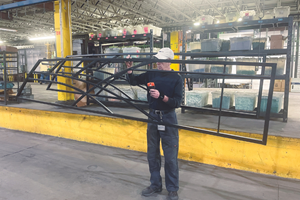Liquid To Powder
What would it take to convert a small liquid booth for powder application? Would simply replacing the typical fiberglass or poly exhaust filter media with some type of micron filter box/panel be sufficient? How likely is it that we can match our vendor’s powder coat finish/color with our own, taking into account the translucent nature of a gloss red? (We’d be uusing the same powder as the vendor)
Q. We currently have a large wet spray booth that we use to coat a variety of steel parts, but I have recently been asked to look into starting up a small batch powder operation. The application would be for making up part shortages of steel and aluminum parts. The thought by some is that we will reap some benefit in coating some emergency parts with powder. Now, I’m very much in favor of powder coating but I’m having a hard time justifying the project and the additional expense.
The quantities of parts that would be appropriate to powder coat are very low, maybe one or two throughout the day maximum. The rest of the parts are either heat -sensitive or too large for the available ovens. The predominant colors would be semi-gloss black and gloss red.
We have a small (133 ft3) oven that should work for us and we have a small open face liquid parts booth being offered to us.
My questions are: 1)What would it take to convert a small liquid booth for powder application? Would simply replacing the typical fiberglass or poly exhaust filter media with some type of micron filter box/panel be sufficient? 2) How likely is it that we can match our vendor’s powder coat finish/color with our own, taking into account the translucent nature of a gloss red? (We’d be uusing the same powder as the vendor.) J.L.
A. Applying a powder coating to a part is much easier than applying a liquid coating, provided you ensure that the part is clean and the powder is fully cured. You may not be able to ever go back to liquid coating your “emergency parts” again once you have the technique down.
Installing a new powder coating process, however, takes some planning and forethought, especially when using equipment designed for applying and curing liquid paint. The first thing you must do is verify that the equipment components you intend to use are suitable for the powder coating process (or can be modified to support the process).
Let’s talk about the oven first. A cure oven for powder coating must have the capability of attaining at least 350°F for most “mainstream” powder formulations. Ideally the oven should be designed to attain 450°F to shorten the cure cycle time. This oven must also have an exhaust rate of 6 to 8 air changes per hour (not normally a problem when using an oven designed for liquid paint). Since the oven will be operating at a higher temperature, the oven should have a metal floor (preferably insulated) to ensure that concrete dust does not spoil your finish. Finally, this oven must have a gentle airflow to bathe the powder coated parts in hot air without blowing the powder off. If your oven has adjustable air outlet slots, this should not be a problem.
The liquid paint booth filters will never stop the powder. Some companies manufacture kits to modify these booths by substituting pocket filters. However, the finer filters often reduce airflow into the fan, decreasing the effectiveness of the powder containment within the booth. This means that you will have powder everywhere. Of course, once you modify this booth it becomes very difficult to spray liquid paint in it unless you change out the filters again. If you try to use the same filters for both liquid and powder coatings, you will end up with a gooey mess that will be difficult to dispose of. My recommendation would be to purchase a small powder coating booth to support your efforts. You will be better off in the long run.
Finally, you should have no difficulties matching the color and gloss of your powder coating to your supplier’s powder coating, especially if it is the same powder. This is provided you properly clean your parts beforehand and fully cure the powder coating. Controlling film thickness will affect the surface smoothness, so be sure you don’t put too much powder on the parts.
Good luck. I promise you will be pleasantly surprised with the results, if you follow my recommendations.
Related Content
Powder Coating Overcomes Post Forming
Six Sigma methodology, open communication, and collaboration produce results for leading boat manufacturer.
Read More12 Ways to Improve Your Powder Coating Quality
Often overlooked powder coating procedures that can help you elevate your quality, streamline your operations and improve your profitability.
Read MoreConveyors and Paint Systems
Choosing the right conveyor system, coating technology, and ancillary equipment.
Read MoreAn Altruistic Growth Strategy Puts People First
Professional Plating emphasizes investing in its team and fostering a supportive environment on the shop floor.
Read MoreRead Next
Education Bringing Cleaning to Machining
Debuting new speakers and cleaning technology content during this half-day workshop co-located with IMTS 2024.
Read MoreDelivering Increased Benefits to Greenhouse Films
Baystar's Borstar technology is helping customers deliver better, more reliable production methods to greenhouse agriculture.
Read MoreEpisode 45: An Interview with Chandler Mancuso, MacDermid Envio Solutions
Chandler Mancuso, technical director with MacDermid Envio discusses updating your wastewater treatment system and implementing materials recycling solutions to increase efficiencies, control costs and reduce environmental impact.
Read More










.jpg;maxWidth=300;quality=90)














